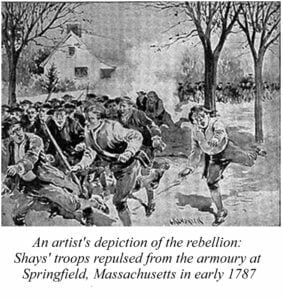
“Enjoy the little things, for one day you may look back and realize they were the big things.”
Robert Brault – American Author
I bet you never realised that a rebellion by a farm hand called Shays led to the American Constitution as we know it today.
It was all because of high Taxes.
You see it all happened because the federal government increased their efforts to collect taxes, it was not popular. The result was that Daniel Shays, a farmhand veteran of the war of independence, led 4,000 people in protest. He marched them to the federal Springfield Armory; he was trying unsuccessfully to attempt to seize its weapons and overthrow the government.
The Government’s problem.
The problem was that federal government couldn’t fund the soldiers to put down the rebellion, therefore this job fell on the Massachusetts State militia.
It showed a problem in the Articles of Confederation.
Many say that this was the catalyst that made the States realise that the Articles of Confederation were inadequate as the country’s governing document. The result of Shay’s actions was to start a vigorous debate throughout the states on whether there was a need for a stronger central government.
It led to a new constitution.
Earlier in 1785, most of the powerful merchants and political leaders had agreed that a stronger central government was needed but nothing was done. Shays’ Rebellion was the catalyst that caused five states to try to thrash out a new constitution. However, they soon realised that they needed all the states involved, therefore, they called for a convention of all of them at Philadelphia in May 1787.
The convention was dominated by those who felt that there needed to be a strong central government, which, I think, came from the Shays Rebellion.
The New Constitution.
Once this new constitution was agreed and in place, President George Washington was quick to use the military power that the constitution gave him when the Whiskey Act was passed. This Act led to protests against the taxes it was imposing, which escalated and were only put down by the powers given to him in the new constitution. The new constitution allowed Washington to instruct the militia to put down what is now known as the Whiskey Rebellion.
The Whiskey Rebellion.
In 1791 a tax, that was applied to all distilled spirits, and soon got the name “Whiskey Tax”, was brought in to help clear down the war debt created due to the American Civil War. The reason for the nickname was that, at this time, drinking American whiskey was becoming such a popular drink that everyone felt the effects of it, which is why it rapidly became known as the “Whiskey Tax”.
The rebellion just kept going and meant that the President, George Washington, felt he had no option but to use the powers given to him in the new constitution and call in the militia.
Who would have thought that a little rebellion organised by a farm hand, called Shays, could have such an effect that it produced a new constitution.
Isn’t history Fun?
10 questions to discuss:
- Who led the rebellion that ultimately led to the creation of the American Constitution?
- What event sparked the rebellion led by Daniel Shays?
- What was the significance of the federal government’s inability to fund soldiers to suppress the rebellion?
- How did Shays’ Rebellion highlight the inadequacies of the Articles of Confederation?
- What was the outcome of Shays’ Rebellion in terms of sparking a debate about the need for a stronger central government?
- What event followed Shays’ Rebellion that led to the drafting of a new constitution?
- Who dominated the constitutional convention that convened in Philadelphia in May 1787?
- How did President George Washington utilize the powers granted to him by the new constitution during the Whiskey Rebellion?
- What was the purpose of the “Whiskey Tax” imposed in 1791?
- Reflecting on the impact of Shays’ Rebellion, how did a seemingly small-scale revolt lead to the creation of a new constitution?
For more on this interesting topic:
© Tony Dalton

